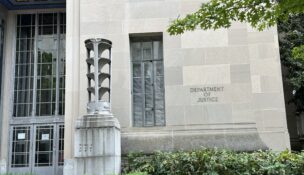Establishment Clause conflict case
By: dmc-admin//September 17, 2007//
|
Key differences between the circuits Should the U.S Supreme Court review the Ninth Circuit’s decision, the court will have to resolve the following
Case: Buono v. Kempthorne, |
“A Latin cross sits atop a prominent rock outcropping known as ‘Sunrise Rock’ in the Mojave National Preserve [in California].”
So begins a recent Ninth Circuit decision holding that the presence of the cross violates the Establishment Clause, even though Congress passed legislation transferring the land underneath the cross to the Veterans of Foreign Wars (VFW).
In doing so, the court created a split with the Seventh Circuit on the effect of a government’s sale of property containing religious memorials.
The court explicitly rejected the presumption employed in the Seventh Circuit, that, “absent unusual circumstances, a sale of real property is an effective way for a public body to end its inappropriate endorsement of religion.”
The decision also creates a constitutional conflict between the courts and the executive and legislative branches.
As a result, it is a strong candidate for review in the U.S. Supreme Court, bringing the analysis employed by the Seventh Circuit in reviewing such actions to come under review as well.
History
A cross was originally erected on the site in 1934 by members of the VFW as a memorial to veterans who died in World War I. The cross has been replaced by private parties several times, but signs dedicated to the veterans are no longer present. The cross serves as a gathering place for Easter religious services, and sits on a 1.6-million- acre preserve, 90 percent of which is federally owned.
In 2001, a district court held that the presence of the cross violates the Establishment Clause.
In response, Congress designated the cross a national memorial — the “White Cross World War I Memorial.” Congress also barred the use of federal funds to dismantle memorials commemorating United States participation in World War I.
In 2003, while the district court decision was on appeal in the Ninth Circuit, Congress conveyed the property underneath the cross (roughly one acre) to the VFW.
The Ninth Circuit later affirmed the holding of the district court that the presence of the cross violated the Establishment Clause.
The plaintiffs in the first action then moved the district court to prohibit the land exchange as an independent violation of the Establishment Clause.
The district court did so, calling the transfer of the property under the cross an evasion of the court’s orders.
The government appealed, arguing that the transfer was a bona fide attempt by Congress to comply with the injunction, but the Ninth Circuit affirmed.
Seventh Circuit Decision
The court acknowledged Seventh Circuit precedent adopting a presumption that a sale of property is an effective way for a public body to end its endorsement of religion. Freedom from Religion Found., Inc. v. City of Marshfield, 203 F.3d 487, 491 (7th Cir. 2000).
However, the court declined to adopt the presumption, citing Establishment Clause jurisprudence recognizing the need to conduct a fact-specific inquiry in this area. Particularly, the court noted the recent Ten Commandments cases, holding one monument constitutional, and another unconstitutional.
Reviewing the district court’s fact-specific inquiry, the court agreed that three aspects supported a finding that the sale of the land was an evasion of the injunction, rather than a bona fide attempt to comply: (1) the government’s continuing oversight and rights in the site containing the cross after the proposed land exchange; (2) the method for effectuating the land exchange; and (3) the history of the government’s efforts to preserve the cross.
|
Related Article |
||
First, under the terms
of the exchange, the government retained ongoing supervisory, maintenance and oversight with respect to the cross and the property, as well as a reversionary interest if it were no longer to be maintained as a war memorial.
Second, the method of transfer was a grant to the VFW, without an open market bidding process for the land. The court agreed with the plaintiffs that the selection of the VFW, a beneficiary with an interest in preserving the cross, as grantee was evidence of the government’s intent to circumvent the injunction.
Third, the court detailed the history of the government’s efforts to preserve the cross: designating the cross a national memorial; appropriating funds to replicate the original cross and plaque; prohibiting the use of federal funds to remove World War I memorials; and finally, directing transfer of the property to the VFW, a private organization.
The court concluded, “We agree with the district court that the government engaged in ‘herculean efforts’ to preserve the cross atop Sunrise Rock. We also agree that ‘the proposed transfer of the subject property can only be viewed as an attempt to keep the Latin Cross atop Sunrise Rock without actually curing the continuing Establishment Clause violation (cites omitted).’”
The court thus concluded that the transfer did not end the government’s improper endorsement of religion, opining, “carving out a tiny parcel of property in the midst of this vast Preserve — like a donut hole with the cross atop it — will do nothing to minimize the impermissible governmental endorsement. Nor does the proposed land exchange under § 8121 end the improper government action. Such a transfer cannot be validly executed without running afoul of the injunction.”
Click here for Case Analysis.
David Ziemer can be reached by email.
Legal News
- Some State Bar diversity participants walk away from program
- Wisconsin court issues arrest warrant ‘in error’ for Minocqua Brewing owner
- Iranian nationals charged cyber campaign targeting U.S. Companies
- Facing mostly white juries, are Milwaukee County defendants of color truly judged by their peers?
- Milwaukee Mayor speaks in D.C. Tuesday at White House water summit
- Chicago man sentenced to prison after being caught with ‘Trump Gun’
- FTC bans non-competes
- Gov. Evers seeks applicants for Dane County Circuit Court
- Milwaukee man charged in dismemberment death pleads not guilty
- Democratic-led states lead ban on the book ban
- UW Madison Professor: America’s child care crisis is holding back moms without college degrees
- History made in Trump New York trial opening statements
WLJ People
- Power 30 Personal Injury Attorneys – Russell Nicolet
- Power 30 Personal Injury Attorneys – Benjamin Nicolet
- Power 30 Personal Injury Attorneys – Dustin T. Woehl
- Power 30 Personal Injury Attorneys – Katherine Metzger
- Power 30 Personal Injury Attorneys – Joseph Ryan
- Power 30 Personal Injury Attorneys – James M. Ryan
- Power 30 Personal Injury Attorneys – Dana Wachs
- Power 30 Personal Injury Attorneys – Mark L. Thomsen
- Power 30 Personal Injury Attorneys – Matthew Lein
- Power 30 Personal Injury Attorneys – Jeffrey A. Pitman
- Power 30 Personal Injury Attorneys – William Pemberton
- Power 30 Personal Injury Attorneys – Howard S. Sicula











